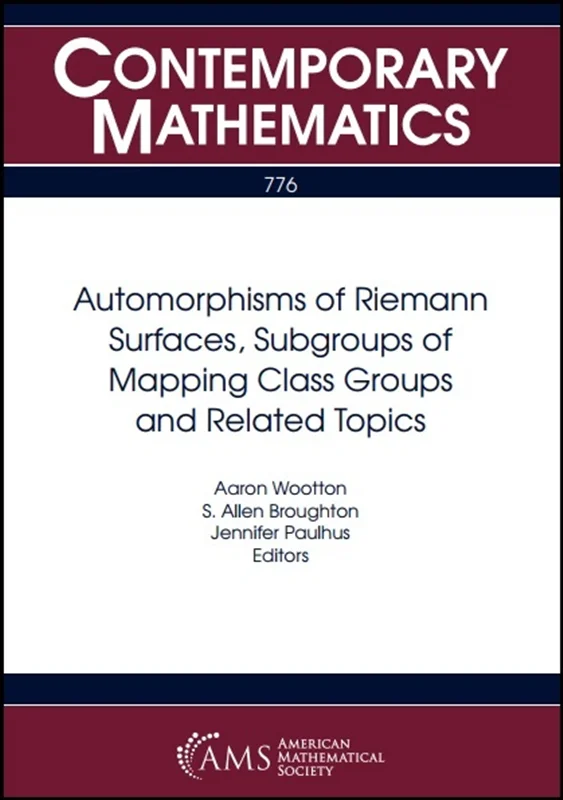Automorphisms of Riemann Surfaces, Subgroups of Mapping Class Groups and Related Topics
Aaron Wootton, 1470460254, 978-1470460259, 9781470460259
English | 2022 | PDF | 13 MB | 366 Pages
Preface
The engaging symmetry of Riemann surfaces: A historical perspective
1. Introduction
2. Compact Riemann surfaces and their automorphisms
3. Hurwitz surfaces and groups and other interesting families
4. Maps and hypermaps
5. Dessins d’enfants and quasiplatonic surfaces
6. Connections with Galois theory
References
Future directions in automorphisms of surfaces, graphs, and other related topics
1. Introduction
2. Preliminaries
2.1. Conformal group actions on surfaces and their construction
2.1.1. Monodromy epimorphisms
2.1.2. Surface kernel epimorphisms
2.2. Equivalence of actions
3. Automorphism groups of Riemann surfaces
3.1. Classification results
3.2. Defining equations for surfaces and automorphisms
3.3. The genus spectrum of a group
3.4. Relationship with subgroups of mapping class groups
3.5. Full automorphism groups and maximal group orders
3.6. Signature realization
4. Families of Riemann surfaces and their moduli
4.1. Hurwitz spaces
4.2. Moduli and Teichmüller spaces
5. Curves
5.1. Extending results from hyperelliptic and superelliptic curves
5.2. Jacobian varieties
6. Graphs, dessins d’enfant and quasiplatonic surfaces
6.1. Dessins d’enfants
6.2. Quasiplatonic surfaces
6.3. Building surfaces and actions from a tiling
6.4. Further directions
7. Symmetries of surfaces
7.1. Symmetries of quasiplatonic surfaces
7.2. Existence of symmetries
7.3. Symmetric ?-gonal actions
8. Algorithms, computations, and explicit methods
8.1. Classifications
8.2. Equivalence relations
8.3. Problems on enumerating actions
9. Acknowledgments
References
Extending Harvey’s surface kernel maps
1. Introduction
2. History and Methods
3. Notation
4. Harvey’s results and Extensions
5. Background: Summary of the Reidemeister-Schreier theory
6. Application of the Reidemeister-Schreier Theorem
7. The symmetric group ?₃ and its multiplication table
8. Detailed Calculations for ?₃
9. Questions
10. Acknowledgments
References
A short proof of Greenberg’s Theorem
1. Introduction
2. The proof
3. Remarks
References
Equivalence of finite group actions on Riemann surfaces and algebraic curves
1. Motivation and overview
2. Preliminaries
3. Rotation data of a ?-action
4. Equivalence of actions
5. Comparison of equivalence relations
6. Analysis of Conflation
References
Planar representations of group actions on surfaces
1. Introduction
2. Preliminaries
3. Skeletal uniqueness property
4. Skeletal signature spaces of SUP Groups: the strategy
5. The ?-SUP group case
6. The ??-SUP group case
7. The ?²-SUP group case for ? odd
8. The 4-SUP group case
Acknowledgments
References
Fiber product of Riemann surfaces
1. Introduction
2. The fiber product of Riemann surfaces
3. The strong field of moduli of the fiber product
4. Isogenous decomposition of the Jacobian variety of fiber products
5. Examples
References
One dimensional equisymmetric strata in moduli space
1. Introduction
2. Preliminaries
3. Covering ?-gonal strata by Hurwitz spaces
4. Case: Orbit genus 0 and 4 branch points
References
Arithmetic of dihedral origami
1. Introduction
2. Elliptic curve and origami set-up
3. Construction
4. Division polynomials
5. Galois representations
6. Diagram
References
Reduction of superelliptic Riemann surfaces
1. Introduction
2. Preliminaries
3. Reduction of the moduli point
4. Reduction of coefficients of binary forms
5. Concluding remarks
References
Dessins d’enfants with a given bipartite graph
1. Introduction
2. Preliminaries
3. Proof of Theorem 1
4. Some classical bipartite graphs
Acknowledgment
References
On infinite octavalent polyhedral surfaces
1. Introduction
2. Background
3. 8(1,1,6) as Schwarz CLP minimal surface
4. A triangulated Swiss cross
5. Figure credits
References
Universal ?-gonal tessellations and their Petrie paths
1. Maps on surfaces
2. Algebraic maps
3. Universal maps and map subgroups
4. Hecke groups
5. Infinite periods
6. The universal ?-gonal map
7. Petrie paths
8. The special cases ?=4,6
9. Even and odd vertices of Petrie paths
10. The principal Petrie paths of ℳ̂₅
References
On the Riemann-Hurwitz formula for regular graph coverings
1. Introduction
2. Preliminary results and definitions
3. Groups acting on a graph without invertible edges
4. Groups acting on a graph with invertible edges
Acknowledgments
References
Cyclic and dihedral actions on Klein surfaces with 2 boundary components
1. Introduction and preliminaries
2. The case ? odd
3. The case ? even: preliminary conditions
4. Cyclic groups
5. Dihedral groups
6. Concluding remarks
References
Finitely generated non-cocompact NEC groups
1. Introduction
2. Preliminaries
3. Surface symbols
4. Canonical presentation
References

